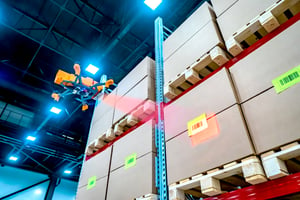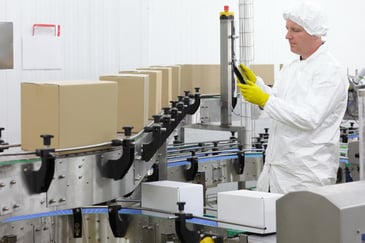 In the consumer-centric and demanding service standards of today’s world, it is no surprise that technology has evolved to be able to optimize everything from manufacturing to delivery of goods. In the logistics and inventory industry, for example, next-day and even same-day arrival of goods are becoming commonplace. Through innovative developments and advanced industrial automation in supply chain processes, shipping times have been greatly reduced, with an efficiency that a mere few years ago was unimaginable.
In the consumer-centric and demanding service standards of today’s world, it is no surprise that technology has evolved to be able to optimize everything from manufacturing to delivery of goods. In the logistics and inventory industry, for example, next-day and even same-day arrival of goods are becoming commonplace. Through innovative developments and advanced industrial automation in supply chain processes, shipping times have been greatly reduced, with an efficiency that a mere few years ago was unimaginable.
All this is due to the somewhat uncomfortable truth, that machine learning and AI are simply more competent when it comes to getting the job done. Factories and warehouses that have implemented revolutionary systems, such as the ones offered by Radwell International Ltd., no longer have to account for human error and have the added advantage of being able to manage all related tasks in a cost-effective and efficient way that is otherwise impossible.
Industry-wide Benefits
Machine learning was specifically designed to cater to industries that deal with large amounts of big data. When it comes to analyzing and comprehending extreme amounts, such tasks are difficult, if not impossible, without the use of AI.
- Manufacturing: Machine learning is present right in the production lines by using analytics to conclude which products are in high demand and in need of replenishment; or conversely, which products should be discontinued. Without any needed interference or involvement from people, production lines can automatically transition to manufacture the desired amount of any specific product.
- Logistics/Inventory Management: Common tasks such as picking, packing, shipping, and tracking of orders are streamlined through a sophisticated system that is able to produce optimal order volumes.
- Pattern-based forecasting: Machine learning systems are able to draw on historical and real-time data to accurately predict future demand of products and shipments, and subsequently use these forecasts to manage stock and inventory in the most cost-effective and efficient way.
This age-old industry is only increasing in relevance, and it is now more crucial than ever to keep up with insatiable consumer demand and standards. Market researchers predict the global logistics industry will reach US$15.5 trillion in the next couple of years. Online retail, which is now arguably the backbone of the entire logistics industry, is expanding at an extraordinary rate. Estimates predict that over 2.14 billion people will be involved in online shopping within the next two years, and with this, comes a plethora of challenges for supply chains.
Any industry participant knows that an extra hour spent sitting in a warehouse, an extra few miles en route, or one more unnecessary pitstop before the final destination can all add up to enormous fees and wasted time. Automated machine learning can help reduce such problems.
Infinite Possibilities
One popular use for smart inventory systems is the enhancement of product location within facilities based on factors such as buying frequency or popular product pairings. This results in an overall reduction in the number of movements and time needed for order fulfilment, as well as a reduction in potential damage to the product.
 Drone scanning, another popular component in machine-learning systems, is able to locate, recognize, count, and inspect stocks in large warehouses, where excessive inventory is a common problem. Drone scanning can perform the same tasks at fifty times the speed with little to no error, eliminating hours of manual labour needed and reducing accuracy and safety risks.
Drone scanning, another popular component in machine-learning systems, is able to locate, recognize, count, and inspect stocks in large warehouses, where excessive inventory is a common problem. Drone scanning can perform the same tasks at fifty times the speed with little to no error, eliminating hours of manual labour needed and reducing accuracy and safety risks.
These types of robotic systems in warehousing have seen a tremendous increase in usage, with giants such as Amazon, Walmart and Alibaba reporting an immediate slash in operating costs, sometimes as high as 22% per warehouse.
In an industry where speed and quality control are the name of the game, machine learning is utilized to greatly manage both of these issues. In the order-picking and delivery stages, where products are more prone to damage, machine learning can determine past fleet performance to further improve both the safe handling of the product as well as formulate and adjust the ideal distribution channels, even for the dreaded last mile delivery dilemma.
The systems can factor in issues related to the location of ships and trucks, weather conditions, traffic and intracity transport conditions, and a range of other seemingly minute factors, which all contribute to delivery time. They are also able to adjust for out-of-the-ordinary shifts in demand during busy times such as holiday seasons or sale festivals. Fast responses to such developments, as well as the added benefit of predicting risks before they occur, are what enable such systems to perform so well.
Besides all this being obviously beneficial for companies themselves, this also greatly benefits end consumers, as on-time order fulfilment ultimately results in greater turnover and customer satisfaction. As consumer demand is a dynamic and quickly changing variable, smart warehousing systems are designed to adapt in order to reduce the probability of overstocking or product scarcity. Such adaptations, in the absence of AI software, would normally require manual assessment by people, followed by lengthy periods of time used for planning and execution.
Sustainability Compliance
 All these benefits, while obviously great for both sides of the delivery equation, have another added advantage: the environment.
All these benefits, while obviously great for both sides of the delivery equation, have another added advantage: the environment.
Freighting and logistics are major contributors to environmental harm and climate change due to the large emission of gases from transportation. The contribution to air pollution is only expected to continue increasing at the current state, and a significant portion of it is derived from unnecessary journeys.
As shipment efficiency improves, meaning that heavy-duty trucks are required to make fewer unnecessary journeys, a large portion of the damage and carbon footprint can be reduced. As such, the entire logistics industry is actively advancing on the road towards sustainability with the help of AI.
Affordable Implementation
The transformation of existing manufacturing and warehousing facilities into smart automated ones may seem like a large and costly move at first. However, a very simple examination of the operational cost reductions makes the entire consideration very easy. Incorporating machine learning is not an immediate transformation, but rather a multi-step plan that starts off with small steps that immediately tackle productivity issues and provide tangible ROI.
Even for businesses on a budget, the integration of AI into various tasks does not have to cost a fortune. Ready-made solutions are offered by many industrial automation providers that take into account different companies' needs. While large corporations may opt for building their own AI systems, today, it is very easy — and cheap — for smaller companies to leverage existing open-source systems, such as Google's TensorFlow.
For an even more affordable integration, it is also wise to use a gradual approach. By slowly introducing machine learning systems into new departments and processes, a more cost-effective and smooth transition can occur as opposed to a complete makeover. Chatbots are a good example of a common AI tool that immediately adds value at a very low cost. Customer service, inquiry re-routing, and other interactions with clients can be handled by such systems instead of large support staff.
Analytics engines are another very effective AI tool that doesn't require a large investment but can still provide an incredible gateway into the world of smart business.
The Question of Job Loss
All this seems too good to be true, so it is only natural to consider possible risks. As many are well aware, the topics of automation and job loss have become almost synonymous when addressing this subject.
This is not new. For many decades, long before AI and machine learning were even recognized concepts, the idea of machines replacing humans has posed an ongoing concern for people. While the concern is valid, it has been disproven time and again. In fact, as historical evidence overwhelmingly proves, embracing developments in such industries can significantly boost job creation and economic development as a whole.
Fast-Approaching Future
Martin Thomas, European Marketing Manager at Radwell said “The final piece to the almost perfect puzzle of industrial automation and machine learning systems lies in the fact that its growth is self-sustained. Machine learning, as the name so blatantly suggests, means that the systems in charge of managing these processes are constantly improving themselves. Through complex self-learning algorithms, smart sensors, and cloud technology, the capabilities of these machines are continuously expanding, and the margin of error is quickly being diminished.
As we just begin to fully understand the capacity that machine learning and AI-based industrial integration contain, it is not long before we are able to perfect the art of flawless, efficient, and superior operations all the way from manufacturing to delivery. At Radwell International Ltd., we are proud to be part of the revolution and strive to keep up with the fast and demanding nature of the industry.”









